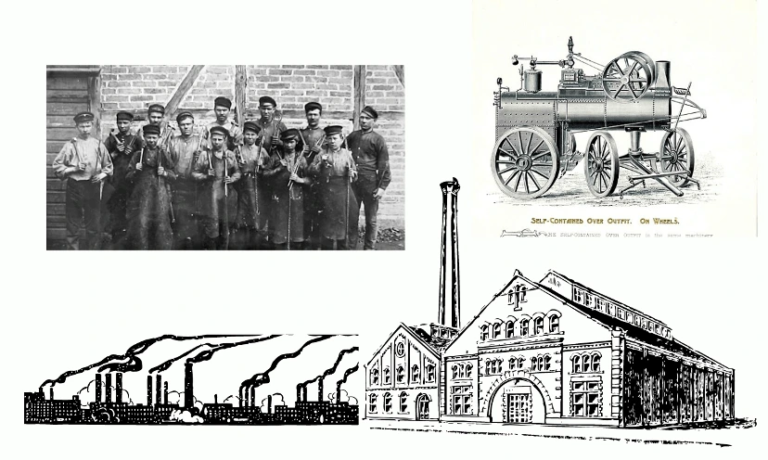How The Industrial Revolution Changed The World
Have you ever wondered how this modern era came to be? Would you like to know the changes in history that ushered in this new era? Look no further than the Industrial Revolution!

This revolution revamped every part of society worldwide from family life to economics and politics. First and foremost, let’s have a look at what the Industrial Revolution was and how it changed the world.
What is the Industrial Revolution?
Spanning from around 1760 to 1840, the first Industrial Revolution marked a pivotal shift from an agrarian and handicraft economy to one dominated by industry and machine manufacturing. For centuries, the societal norms of the Middle Ages had prevailed, with most people living and working in small rural communities, rarely venturing beyond their local vicinity.
However, the 18th century saw significant demographic changes. A rising population and a burgeoning workforce set the stage for rapid urbanization, spurred by the growth of factories. Britain emerged as the hub of this industrial transformation, fueled by a host of inventors and technological advancements.
Advancements in Technology
The seeds for technological advancements were sown by the Scientific Revolution, which had already significantly altered people’s understanding of the world. This era of discovery and innovation provided the necessary groundwork for the Industrial Revolution’s technological developments.
The steam engine, invented by Thomas Newcomen in 1712, was a key invention that would eventually revolutionize transportation. James Watt later enhanced this design, increasing its power output, and making it suitable for railway locomotives and powering new mills.
But the innovations weren’t limited to transportation.
Throughout the 18th century, groundbreaking inventions transformed textile, iron, and steel production. Starting with John Lombe’s silk-throwing mills in 1719, the period saw the introduction of efficient weaving machines and other technologies that significantly increased the production rate of fabrics like wool. By the 1850s, Britain alone was responsible for producing half of the world’s manufactured goods, a testament to the widespread industrial growth across Europe.
Impact on Traditional Crafts and Skills
The rise of machinery, capable of producing goods more efficiently and in larger quantities, inevitably led to the decline of traditional artisanal handicrafts. While some skills managed to survive, the overwhelming demand for mass-produced items diminished the need for handmade products.
Furthermore, with the decentralization of domestic systems during the Industrial Revolution, people who previously made a living on traditional crafts were forced to work in factories to earn an income.
Economic Transformation and Impact on International Commerce
The Industrial Revolution’s influence extended far beyond Britain, reshaping the entire world. Western Europe soon emulated Britain’s industrial model, and eventually, America followed, particularly after World War I. America’s development of its own manufacturing capabilities, utilizing both British inventions and homegrown innovations, positioned it as a significant force in global trade.
- Mass Production
The era witnessed a ‘consumer revolution’ with an increasing array of goods becoming accessible to the general public. As production methods grew more efficient, Britain was able to satisfy not only its domestic demands but also those of international markets, especially in its overseas colonies.
- Expansion of Global Trade
Advancements in transportation and the development of better roads facilitated faster and more widespread movement of goods. This era marked the beginning of a globalized trade network, effectively creating a ‘highway system’ that interconnected continents like never before.
The Transformative Impact on Society
As factories proliferated in urban areas, a significant shift toward urbanization occurred. People increasingly moved from rural villages to cities and towns, attracted by the prospect of higher wages. Consequently, many smaller towns and villages grew into major urban centers. However, despite higher wages in cities, some scholars note that the cost of living, particularly rent, was also higher, potentially diminishing the quality of life compared to rural areas.
- The Rise of the Working Class
The Industrial Revolution heralded the emergence of a distinct working class. This development altered family dynamics and the simplicity of rural life. Men often left their families to work in factories, in stark contrast to the previous rural economy where families typically worked together in farming, running a shop, or weaving.
The widespread establishment of industries also marked the unfortunate beginning of child labor. To supplement family income, women and children often worked as servants or in factories. During this period, a significant wage gap emerged, with women and children receiving substantially lower pay, often for working in more hazardous conditions and for long hours, sometimes up to 14 hours a day.
- Cultural Expressions and Political Movements
With the advent of the Industrial Revolution, capitalism emerged as the dominant economic system, prompting societal restructuring. New social classes formed, with varying attitudes towards capitalism; some were critical of its principles, while others sought to find their place in this newly industrialized world.
Legacy of the Industrial Revolution and ongoing socioeconomic transformations
The Industrial Revolution played a vital role in laying the groundwork for modern society. This period changed the course of world history by making goods, communication, and transportation more affordable and accessible to society. Furthermore, this revolution was what ignited the future industrial revolutions, from steam power and mechanization to electricity, automobiles, robotics, and the internet.
Despite the positives, the negatives cannot be ignored as we are still reeling from the impact the Industrial Revolution had on the environment, family life, and working conditions.
Conclusion
The first industrial revolution was what set the domino effect for the rapid advances in technology and other industrial revolutions that came after. Without industrialization, we would not have the developed societies and innovations we have now.
However, we are also still grappling with the shadows it cast. The revolution might be over but we are still plagued by inequality, environmental issues, and weakened institutions of family. Nevertheless, its echoes continue to shape our modern lives.
